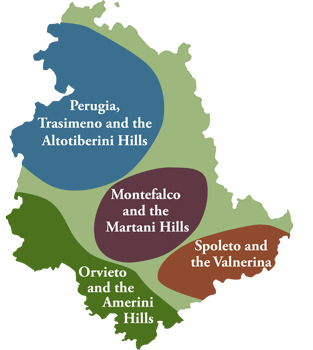
Local delicacies and typical products of Umbria
Umbria is a region rich with a long standing tradition of local farm fresh delicacies. Many wonderful products such as DOC and IGT wines, DOP and IGP foods made in the Umbrian style.
There are two different categories where you can find places to taste, buy, and explore the wide array of typical Umbrian products:
Local Producers: Agricultural producers and sellers of typical Umbrian products; organic farms, small producers, family run and businesses.
Specialty Food Shops: Retail food shops specializing in local and traditional Umbrian DOP and IGP delicacies.

DOP Products of Umbria

Extra Virgin Olive Oil DOP
The fertile rolling hills of Umbria hava a long tradition associated with the cultivation of olive trees, as evidenced by the nearly thirty thousand acres of olive groves that cover the surface, and more than 250 regional mills. The entire region has a number of areas well known for their excellent extra virgin olive oil; Colli del Trasimeno, Colli Assisi and Spoleto, Colli Amerini, Martan and Orvieto. The main regional varieties of olive trees are Moraiolo, Frantoio and Leccino, while other varieties such as the San Felice (Montefalco – Gualdo Cattaneo), the Rajo (Amelia) and Sweet Agogia (Trasimeno). The taste that comes from the various growing areas accentuates or decreases the feeling of pleasant bitterness or spice on the palate, leaving in each case the tasty fruit flavors typical Umbrian olive oil.
Farro (Spelt) di Monteleone di Spoleto DOP
This ancient grain is well suited to the arid and hilly land of Umbria, and is widely used in regional cuisine. Farro di Monteleone di Spoleto is the only species that produces a light tobacco colored flour instead of white. In the kitchen it is used in soups, salads, and the flour is used to prepare cakes, pies, and cookies.
Pecorino Toscano DOP
A great cheese made with pasteurized sheep’s milk made differently in the central regions of Italy, including, Umbria, Tuscany and Lazio. It is produced in the western areas of Umbria around the Trasimeno lake, the territory of Allerona and hills of Orvieto.
Salamini Cacciatori DOP
A salami cold cut of the great traditional regional delis, in which Umbria has a great tradition. It is made with lean and fat pork meat, with a length of about 20 cm, and an average weight of 350 grams. It slices compact and homogeneously, ruby red in color with flecks of well distributed white fat. The taste is sweet and delicate.
IGP Products of Umbria

Vitellone bianco dell’Appennino IGP
The great tradition of norcina (pork butchers) and the prevalence of poultry and other farm animals is not to suggest that in Umbria beef does not have great importance. In fact its territory has numerous herds of cattle, especially the White Bullock of the central Apennines. The meat from both male and female cattle are used for; Chianina, Marche, Romagna (aged between 12 and 24 months, born and bred in one geographical area of production).
Prosciutto Crudo di Norcia IGP
Another delicious product of Umbria, prepared and worked in the areas of Norcia, Cascia, Monteleone di Spoleto, and Preci Poggiodomo, places with an altitude of over 500 meters above sea level. Climate is one important factor in the production phases, as is the quality of the meat (only “heavy” pig specimens, adult male and female) and the method of curing. Of this great product you can appreciate the look and taste, almost spicy, but not salty.
Lenticchia (Lentils) di Castelluccio IGP
In addition to the prosciutto of Norcia, the eastern side of the region has another product of gastronomic excellence, Castelluccio lentils. This rich, small and tasty legume is produced in the great plains of the enchanting village of Castelluccio di Norcia (at approx. 1,500 meters above sea level) small size with a thin tender skin. Precisely because of the high altitude at which it growns, the Castelluccio lentils do not require any treatment, and this keeps all the great taste and nutritional properties intact. In the region this legume is used for soups, salads and even with fish such as salmon and anchovies.
Patata Rossa (Red Potato) di Colfiorito IGP
A traditional vegetable from the area of Colfiorito, recognized by its thin rough dull red skin, and crisp pale yellow meat. In the kitchen it is suitable for every type of preparation: boiled, grilled, or under ashes, salads, fried, roasted, or used to produce breads, even mashed to be used as a base for excellent desserts such as ciambelle di patata rossa.
Other Traditioal Products of Excellence from Umbria

Slow Food in Umbria
The Slow Food movement supports small producers valuing traditional territories and traditional techniques, with the aim to preserve and prevent extinction of particular breeds and varieties of fruits and vegetables.
Umbria’s seven protected products are: Sedano Nero of Trevi, Mazzafegati and Vinsanto Affumicato dell’Alta Valle del Tevere, Roveja, Fagiolina of the Trasimeno, Fava cottora, and Cicotto Umbro (Grutti).
Cipolla (Onion) di Cannara
Grown in a restricted area of Umbria with potassium rich clay soil and water. It is a product of great quality and taste, and a base of many dishes from Umbria.
Sedano (Celery) Nero di Trevi
Produced in small quantities and now grown only in certain areas around Clitunno and Trevi, this celery has a dense and tender meat with typical ribs, and is especially popular in local dishes such as parmigiana di sedano nero.
Fagiolina (Bean) del Trasimeno
Another legume whose name explains its origins and where it is cultivated today in the towns around the Trasimeno lake. A legume delicious and savory in flavor with a soft texture, ideal for soups and salads, or cooked in a pan with tomato and sauteed garlic.
Fava Cottòra di Amelia
A delicious legume small in size but big in taste, typical of Amerino. Enjoyable in many ways, with extra virgin olive oil, salt, pepper and fresh onion bruschetta or as a pate made from crushed beans, extra virgin olive oil and fennel. Also popular is the “striscia con le fave” in this case the fava beans are boiled and seasoned with fat obtained from the dissolution of the cooking fat and low-fat obtained from the ventral part of the pig.
Pane (Bread) di Strettura
This antique bakery product named for a village between Spoleto and Terni, is made by mixing water, wheat flour and natural yeast. This bread has a very slow rising time and is “sour”, and cooked in a wood-burning oven fueled by small local shrubs.
Roveja di Cascia e Civita
A small pea-like legume that is typical of the eastern side of Umbria. Ideal for soups, or eaten plain with extra virgin olive oil. In some areas it is reduced to flour to make a special polenta (farecchiata) topped with chopped anchovies and parsley or broccoli.
Zafferano (Saffron)
Mainly from Cascia and the territory of Gubbio and Città della Pieve, Umbrian saffron is of the highest quality and very appreciated in the kitchen for preparing dishes with strong fragrant flavors.
Fagiolo (Bean) di Cave
Produced in two varieties (light green and yellow) in the small hamlet quarries on the Topino river in Foligno, has a light savory taste and is characterized by a very thin skin.
Patata Bianca (White Potato)
Widespread and appreciated potato of Pietralunga nell’eugubino it is ideal for dumplings, pies and mashed (amidosa). They are different from the more famous Rossa di Colfiorito (IGP) and Campitello.
Tartufo Nero (Black Truffle) di Norcia
The black gold of Norcia and the Apennines of Umbria, a precious tuber with an intense flavor, able to enhance any dish. From pasta to second courses, and even salads and side dishes. Every year in Umbria there are events and fairs dedicated to black and white truffles. The most important are in Norcia, Pietralunga, Città di Castello, and Fabro.
Tartufo Bianco (White Truffle) della Valtiberina
A superb product of the earth, the white truffle is found in different parts of Umbria, but particularly in the northern part of Chiasco and high Valtiberina, between Gubbio and Citta di Castello. This town is also home to a traditional annual trade show dedicated to this precious tuber.
Broccoletti del Trasimeno
A vegetable grown especially in the land around the lake, which has special geological characteristics being very sandy. It has a pleasantly bitter taste making it a great side dish. It also goes very well with sausages and roast meats, or as a condiment for focacca and salty tortes.
Fagiolo Secondo del Piano di Orvieto
A special type of bean produced since the end of the 19 century in the valley along the Paglia river fields (this territory is called “Piano di Orvieto”).
 Wine Production
Wine Production Wine Tastings
Wine Tastings Restaurant
Restaurant Wine Retail
Wine Retail Products Retail
Products Retail Bio Production
Bio Production Beer Production
Beer Production